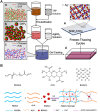Efficiency of Multifunctional Antibacterial Hydrogels for Chronic Wound Healing in Diabetes: A Comprehensive Review
- PMID: 35909814
- PMCID: PMC9326039
- DOI: 10.2147/IJN.S363827
Efficiency of Multifunctional Antibacterial Hydrogels for Chronic Wound Healing in Diabetes: A Comprehensive Review
Abstract
Diabetic chronic wounds or amputation, which are complications of diabetes mellitus (DM), are a cause of great suffering for diabetics. In addition to the lack of oxygen, elevated reactive oxygen species (ROS) and reduced vascularization, microbial invasion is also a critical factor that induces non-healing chronic diabetic wounds, ie, wounds still remaining in the stage of inflammation, after which the wound tissue begins to age and becomes necrotic. To clear up the infection, alleviate the inflammation in the wound and prevent necrosis, many kinds of hydrogel have been fabricated to eliminate infections with pathogens. The unique properties of hydrogels make them ideally suited to wound dressings because they provide a moist environment for wound healing and act as a barrier against bacteria. This review article will mainly cover the recent developments and innovations of antibacterial hydrogels for diabetic chronic wound healing.
Keywords: antibacterial; diabetic chronic wound; hydrogel; infection; inflammation; wound dressing.
© 2022 Ji et al.
Conflict of interest statement
There are no conflicts of interest to declare.
Figures






References
Publication types
MeSH terms
Substances
LinkOut - more resources
Full Text Sources
Medical

